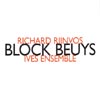Rinjvos Block Beuys
A major statement from a notable young Dutch composer
View record and artist detailsRecord and Artist Details
Composer or Director: Richard Rijnvos
Genre:
Chamber
Label: Hat-Hut
Magazine Review Date: 1/2005
Media Format: CD or Download
Media Runtime: 78
Mastering:
Stereo
DDD
Catalogue Number: HATN147

Tracks:
| Composition | Artist Credit |
|---|---|
| Block Beuys - Raum 2 |
Richard Rijnvos, Composer
Ives Ensemble Richard Rijnvos, Composer |
| Block Beuys - Raum 1 |
Richard Rijnvos, Composer
Ives Ensemble Richard Rijnvos, Composer |
| Block Beuys - Raum 3 |
Richard Rijnvos, Composer
Ives Ensemble Richard Rijnvos, Composer |
| Block Beuys - Raum 4 bis 7 |
Richard Rijnvos, Composer
Ives Ensemble Richard Rijnvos, Composer |
Author: Fabrice Fitch
It’s always quite moving to take in at one sitting a work that has taken its composer years to write. In this 78-minute cycle for tape and a maximum of 21 instruments, one cannot help but be sensitised to this aspect of space, of the resonance of space. Composed between 1995 and 2000, it is a response to a set of rooms in Darmstadt housing works by the German visual artist Joseph Beuys. Of its four sections, the second and fourth are most richly scored (adding winds and brass), and the first and last are the longest.
Rijnvos’s style might be described as post-minimalist (perhaps even post-Feldman, though his basic materials tend to be more complex than Feldman’s). His idiom is rich enough to admit of many other influences (in the monumental brass and wind chords of the second ‘room’ I heard echoes of Ferneyhough, whom Rijnvos counts among his teachers); but the overall impression is of a single voice, focused, subtle and, again, monumental.
Each section or ‘room’ replicates the relative dimensions of the Darmstadt rooms. One of the most interesting aspects of Block Beuys is its exploration of this problem: to what extent can space be used as a metaphor for musical materials and discourse. The tape part projects this exploration outwards, at times assuming the role of backdrop, at times being thrust further forward; near the end of the first section, the backdrop stands on its own in a passage of quite haunting beauty.
The third section introduces Beuys’s voice, taped giving a lecture a year or so before his death in 1986. It is instructive to be reminded how the presence of a speaking voice alters one’s sense of musical time. In the fourth and final piece, the music's underlying rhythmic layering is made explicit for the first time. Each section brings something distinctive, but without ever straying from the work’s basic set of assumptions.
For those willing to experience it at one go it cannot fail to make an impact; I’m certain it will continue to resonate with me for some time. Christopher Fox’s booklet-notes are very informative, and the performance from the Ives Ensemble and the sound recording are both exemplary. Don’t miss this.
Rijnvos’s style might be described as post-minimalist (perhaps even post-Feldman, though his basic materials tend to be more complex than Feldman’s). His idiom is rich enough to admit of many other influences (in the monumental brass and wind chords of the second ‘room’ I heard echoes of Ferneyhough, whom Rijnvos counts among his teachers); but the overall impression is of a single voice, focused, subtle and, again, monumental.
Each section or ‘room’ replicates the relative dimensions of the Darmstadt rooms. One of the most interesting aspects of Block Beuys is its exploration of this problem: to what extent can space be used as a metaphor for musical materials and discourse. The tape part projects this exploration outwards, at times assuming the role of backdrop, at times being thrust further forward; near the end of the first section, the backdrop stands on its own in a passage of quite haunting beauty.
The third section introduces Beuys’s voice, taped giving a lecture a year or so before his death in 1986. It is instructive to be reminded how the presence of a speaking voice alters one’s sense of musical time. In the fourth and final piece, the music's underlying rhythmic layering is made explicit for the first time. Each section brings something distinctive, but without ever straying from the work’s basic set of assumptions.
For those willing to experience it at one go it cannot fail to make an impact; I’m certain it will continue to resonate with me for some time. Christopher Fox’s booklet-notes are very informative, and the performance from the Ives Ensemble and the sound recording are both exemplary. Don’t miss this.
Discover the world's largest classical music catalogue with Presto Music.

Gramophone Digital Club
- Digital Edition
- Digital Archive
- Reviews Database
- Full website access
From £8.75 / month
Subscribe
Gramophone Full Club
- Print Edition
- Digital Edition
- Digital Archive
- Reviews Database
- Full website access
From £11.00 / month
Subscribe
If you are a library, university or other organisation that would be interested in an institutional subscription to Gramophone please click here for further information.




